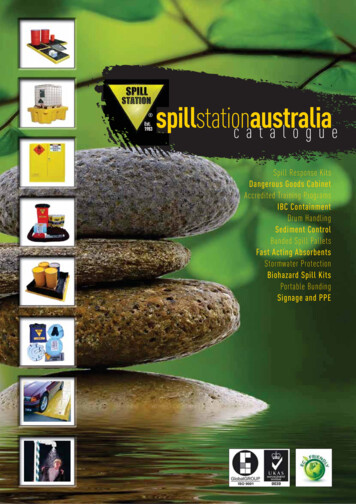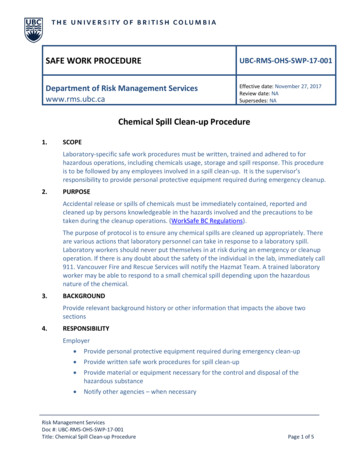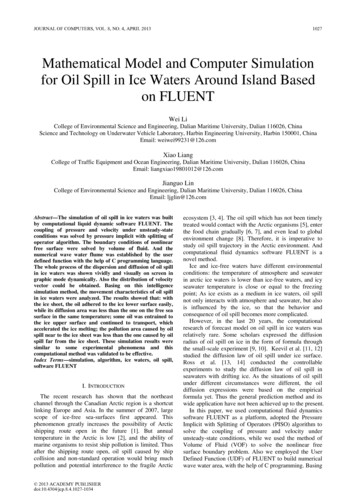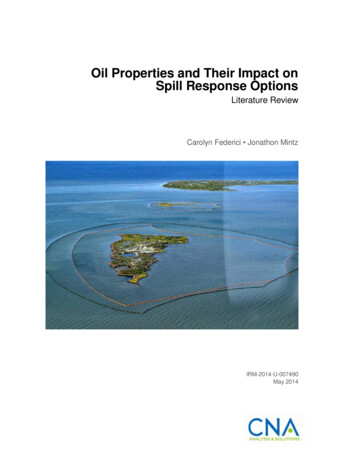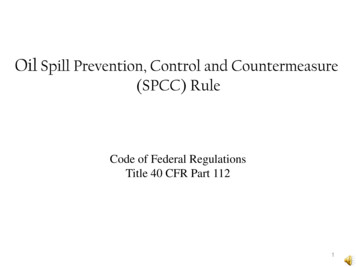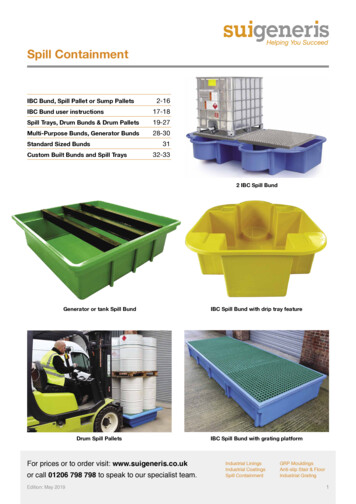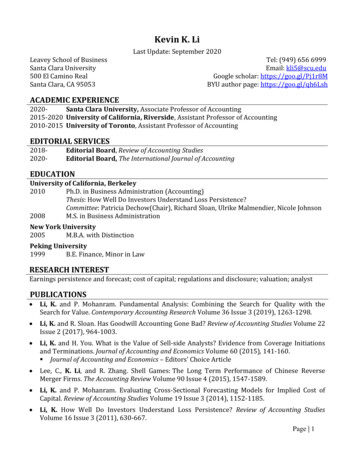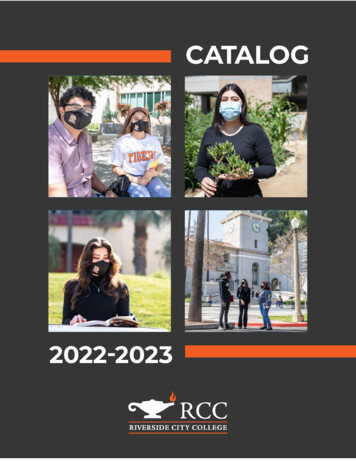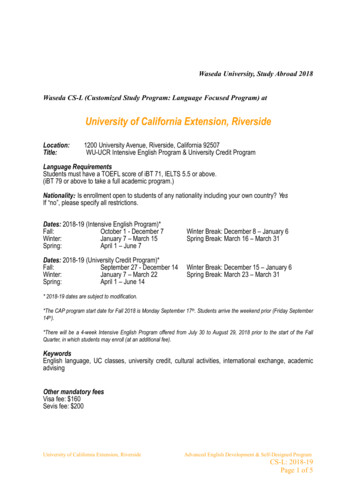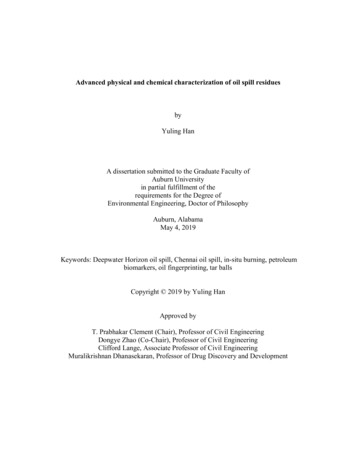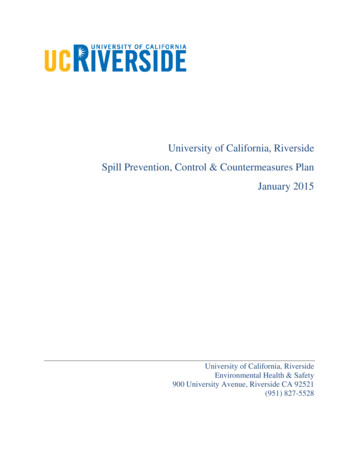
Transcription
University of California, RiversideSpill Prevention, Control & Countermeasures PlanJanuary 2015University of California, RiversideEnvironmental Health & Safety900 University Avenue, Riverside CA 92521(951) 827-5528
Certifications and ApprovalSPCC Plan Certification and Management ApprovalCertification of Applicability of Substantial Harm CriteriaUniversity of California, RiversideSpill Prevention, Control & Countermeasures Plan, January 2015Certifications and Approval
Certifications and ApprovalsSPCC Plan Certification . iSPCC Plan Management Approval . iCertification of Applicability of Substantial Harm Criteria . iiTable of Contents1.2.Introduction and Plan Content.11.1Plan Purpose and Objectives .11.2Plan Review and Update Requirements .11.3Record of Plan Review and Amendments .21.4SPCC Plan Designated Persons and Emergency Contacts .31.5SPCC Plan Administration .41.6SPCC Plan Distribution List .51.7Description of Emergency Procedures and Notifications .51.8Cross-Reference of SPCC Plan Requirements .8Facility Information.142.1Facility Identification .142.2Vicinity Map .152.3Facility Map .152.4Facility Description .162.4.1 Physical Plant Operations .162.4.2 Grounds Maintenance, Refuse & Recycling .162.4.3 Agricultural Operations .162.4.4 Housing, Dining and Residential Services.172.4.5 Fleet Services .182.4.6 Highlander Union Building.182.4.7 UCR Extension .182.4.8 Environmental Health & Safety .182.5Available Spill Cleanup Equipment and Supplies .192.6Spill History .192.7Facility Drainage .192.7.1 Surface Flow Drainage Pattern .192.7.2 Receiving Water Body .202.7.3 Rate of Spill and Worst Case Scenario .202.8Oil Storage .202.8.1 Aboveground Bulk Storage Containers .202.8.2 Portable Oil Storage .21University of California, RiversideSpill Prevention, Control & Countermeasures Plan, January 2015Table of Contentsi
3.4.5.6.2.8.3 Oil-filled Operational Equipment .212.8.4 Non-regulated Oil Storage .21Transfer Operations .223.1Bulk Storage Container Filling Procedures .223.2Product Dispensing Procedures .223.3Loading Dock Operations .23Security.234.1Facility Gates and Fences .234.2Lighting .234.3Bulk Storage Container Fill Box Locks and Dispensers .244.4Protection from Vehicles .244.5UC Riverside Police Department .24Training, Inspections, and Records .245.1Plant Personnel Training .245.1.1 Proper Bulk Storage Container Filling and Product Dispensing .245.1.2 Training for Spill Prevention and Cleanup .255.2Inspections .255.2.1 Double Wall Bulk Storage Containment Inspections .255.2.2 Portable Container Inspections .265.2.3 Mechanical and Electrical Inspections.265.2.4 Annual SPCC Plan Compliance Inspection .265.3Record Retention .26Conformance to Applicable Standards .26TablesTable 1-1 SPCC Plan Revisions . 2Table 1-2 SPCC Plan Contacts List . 4Table 1-3 Cross-Reference of SPCC Plan Requirements . 8FiguresFigure 1- Site Vicinity Map – University of California, Riverside . 15AppendicesAppendix AAppendix BAppendix CAppendix DAppendix EAppendix FFacility MapSpill Cleanup Equipment, Supplies, and ContractorsFacility Oil Storage TableFuel Storage Tank Filling and Dispensing ProceduresSample SPCC Plan Inspection ChecklistSpill Response Procedures PostingsUniversity of California, RiversideSpill Prevention, Control & Countermeasures Plan, January 2015Table of Contentsii
University of California, Riverside Spill Prevention, Control &Countermeasures Plan1. Introduction and Plan ContentThis Spill Prevention, Control & Countermeasures (SPCC) Plan has been prepared for theUniversity of California, Riverside campus (UCR) located in Riverside, California. This planhas been developed in accordance with 40 CFR Part 112 general requirements for SPCCPlans.This plan has been specifically been created to address potential spills from oil storagecontainers and bulk storage containers at the UCR campus. As of the preparation of the mostrecent five-year review, UCR’s aboveground oil storage capacity is approximately 58,503gallons.1.1 Plan Purpose and ObjectivesThe objectives of this plan are to define the spill prevention, control, and countermeasuresimplemented by the facility. The plan is an integral part of establishing an efficient andeffective spill prevention program. The SPCC Plan addresses the following topics: Inspection and Records Facility Drainage Bulk Storage Tanks Mobile or Portable Containers Oil-filled Operational Equipment Personnel Training and Spill Prevention Procedures Bulk Liquid Transfer Operations Security1.2 Plan Review and Update RequirementsThis plan shall be reviewed and updated at least once every five years. The five-year review,and any technical amendments to the SPCC Plan, must be re-certified by a ProfessionalEngineer (P.E.). The SPCC Plan Designated Person shall be responsible for all reviews andupdates made to this plan. Updates and amendments to the SPCC Plan shall be certified andimplemented within six months of approval.The SPCC Plan may be periodically amended to reflect changes in the campus. The plan willbe reviewed and updated when necessary under the following circumstances: When there is a change in the facility design, construction, operation, or maintenancethat materially affects its potential for an oil dischargeUniversity of California, RiversideSpill Prevention, Control & Countermeasures Plan, January 2015Page 1
Subsequent to the commission or decommission of any aboveground bulk storagecontainer with a capacity of 55 gallons or greater Subsequent to the replacement, reconstruction, or movement of any aboveground bulkstorage container with a capacity of 55 gallons or greater Subsequent to any construction or demolition that could alter a secondary containmentsystems of any aboveground bulk storage container with a capacity of 55 gallons orgreater Subsequent to any revisions of standard operation and maintenance procedures at thefacility If there is a release of more than 1,000 gallons of oil in a single discharge or more than42 gallons in each of two discharges during a 12-month period If required by the Regional Administrator1.3 Record of Plan Review and AmendmentsA review and evaluation of this SPCC Plan shall be completed at least once every five years{§112.5(b)}. As a result of the review, this Plan shall be amended within six months to includemore effective prevention and control measures for the facility, if applicable. Such measureswill be implemented as soon as possible, but no later than six months following the Planamendment. Completion of the review, evaluation and Plan amendment shall be documentedat Table 2-1, SPCC Plan Revisions.Table 1-1 SPCC Plan d ByWGRSouthwestWGRSouthwestReason t list,distribution list& tank list;update locationmap; add sectionshowing eachregulatorysection and thepage number inthe Plan thatmeets thatrequirementUniversity of California, RiversideSpill Prevention, Control & Countermeasures Plan, January 2015Section RevisedReason forReviewAll New-Section 2, Table4.1, Contactlists, locationmapRequiredreview andrecertificationPage 2
RevisionNo.2Date1/30/2015Revised ByALTAEnvironmentalReason forRevisionFive-yearreviewSection RevisedUpdate oilstorage list,update FacilityMap, updateemergencycontact list,updateemergencyprocedures andnotifications,update spillcleanupequipment andcontractors,update crossreference ofSPCC PlanrequirementsReason forReviewRequiredfive-yearreview andrecertification1.4 SPCC Plan Designated Persons and Emergency ContactsThe SPCC Plan Designated Person is Amanda Grey. A copy of this SPCC Plan is available forreview at EH&S. Alternate Designated Persons are Russell Vernon and Scott Corrin. Primary Contact:Amanda GreySPCC Primary Designated PersonEnvironmental Programs Manager, EH&SBusiness Phone: (951) 827-2416Cell Phone: (714) 323-2052 Secondary Contacts:Russell Vernon, SPCC Alternate Designated PersonDirector, Environmental Health &SafetyBusiness Phone: (951) 827-5119, extension 2-5119Cell Phone: (951) 295-4904Scott Corrin, SPCC Alternate Designated PersonCampus Fire MarshalBusiness Phone: (951) 827-6309, extension 2-6309Cell Phone: (951) 212-3679All emergency and notification contact information is listed in Table 3-1, SPCC Plan ContactsList.University of California, RiversideSpill Prevention, Control & Countermeasures Plan, January 2015Page 3
Table 1-2 SPCC Plan Contacts ListContact Organization/PersonUC Riverside SPCC ProgramAmanda GreySPCC Primary Designated PersonEnvironmental Programs Manager, EH&SRussell VernonSPCC Alternate Designated PersonDirector, Environmental Health & SafetyScott CorrinSPCC Alternate Designated PersonCampus Fire MarshalUC Riverside Police DepartmentOil Spill Cleanup ContractorClean Harbors Environmental ServicesField Services Office7979 Palm Avenue, Unit EHighland, CA 92346Alternate Oil Spill Cleanup ContractorPSC Environmental Services/StericycleEnvironmental Solutions2490 W. Pomona Blvd.Pomona, CA 91768City of Riverside Fire DepartmentCounty of Riverside Department of EnvironmentalHealth (Certified Unified Program Agency-CUPA)California Governor’s Office of Emergency Services(Cal OES)National Response CenterTelephone NumberBusiness Phone: (951) 827-2416Cell Phone:(714) 323-2052Business Phone: (951) 827-5119Cell Phone:(951) 295-4904Business PhoneCell Phone:(951) 827-6309(951) 212-367924-Hour Phone: (951) 951-5222Emergency Phone (800) 645-8265Office Phone(909) 742-7477Emergency Phone (877) 577-2669Office Phone(909) 598-4449(951) 826-5737Toll Free Phone: (888) 722-4234Office Phone:(951) 358-5055(800) 852-7550(800) 424-88021.5 SPCC Plan AdministrationThe SPCC Plan Primary Designated Person will maintain control over the SPCC Plan/SPCCProgram, and will work with the following UCR departments responsible for oil storage toimplement the plan: Physical Plant Agricultural Operations Housing, Dining and Residential Services Fleet Services Highlander Union Building UCR ExtensionUniversity of California, RiversideSpill Prevention, Control & Countermeasures Plan, January 2015Page 4
1.6 SPCC Plan Distribution ListCopies of the SPCC Plan are distributed to and maintained at the following UCR departmentlocations: Environmental Health & Safety900 University AvenueRiverside, CA 92521 Physical Plant Electric ShopCorporation Yard Building A3401 Watkins DriveRiverside, CA 92521 Physical Plant Grounds: Maintenance, Refuse & RecyclingCustodial & Grounds BuildingEast Campus DriveRiverside, CA 92521 Agricultural Operations1060 Martin Luther King BoulevardRiverside, CA 92506 Housing, Dining and Residential ServicesHousing Operations3498 Avocado AvenueRiverside, CA 92506 Fleet ServicesCorporation Yard Building C3401 Watkins DriveRiverside, CA 92521 Highlander Union Building353 Highland Union Building (HUB)Riverside, CA 92507 UCR Extension1200 University AvenueRiverside, CA 92507 UC Riverside Police Department3500 Canyon Crest DriveRiverside, CA 925071.7 Description of Emergency Procedures and NotificationsThe following are descriptions of immediate actions, procedures and notifications for facilitypersonnel in the event of a discharge {§112.7(a)(3)(iv) and §112.7(a)(5)}. This information isprovided at bulk storage container and portable storage areas in the format shown at AppendixUniversity of California, RiversideSpill Prevention, Control & Countermeasures Plan, January 2015Page 5
F, Spill Response Procedures Postings:In the event of a leak or spill of oil, the following immediate actions should be taken:1.If there is a fire, injury, or spill to the storm drain, immediately call 911 or UCRiverside Police Department at extension 2-5222 or (951) 827-52222.If possible, stop the flow of oil or fuel3.Isolate and contain the spill by creating an earthen berm, or contain with absorbentmaterial from a spill kit, using a shovel or other available equipment (beware of firedanger)4.Estimate the amount of spilled oil or fuel5.Make the required notifications6.Use available cleanup equipment and/or spill cleanup contractors to cleanup the spill,absorbent material, and any contaminated soil7.Document all spill response and cleanup efforts, including notification callsIn the event of a leak or spill of oil that cannot be cleaned up using campus resources, thefollowing may be contacted: Clean Harbors Environmental ServicesField Services Office7979 Palm Avenue, Unit EHighland, CA 92346Emergency Phone (800) 645-8265Office Phone(909) 742-7477 PSC Environmental Services/Stericycle Environmental Solutions2490 W. Pomona Blvd.Pomona, CA 91768Emergency Phone (877) 577-2669Office Phone(909) 598-4449In the event of a leak or spill of oil, one of the following persons must be notified: Amanda Grey, SPCC Primary Designated PersonEnvironmental Programs Manager, EH&S(951) 827-2416, extension 2-2416 Russell Vernon, SPCC Alternate Designated PersonDirector, EH&S(951) 827-5119, extension 2-5119University of California, RiversideSpill Prevention, Control & Countermeasures Plan, January 2015Page 6
Scott Corrin, SPCC Alternate Designated PersonCampus Fire Marshal(951) 827-6309, extension 2-6309In the event of a leak or spill of oil, and the SPCC Designated Person or Alternate DesignatePerson(s) cannot be notified, the following must be contacted: UC Riverside Police Department(951) 827-5222UC Riverside Police Department will notify EH&S and the Campus Fire MarshalIn the event of a leak or spill of oil, the following regulatory agency notifications must be made: National Response Center(800) 424-8802 California Governor’s Office of Emergency Services (Cal OES)(800) 852-7550 County of Riverside Department of Environmental Health(951) 358-5055City of Riverside Fire Department(951) 826-5737In the event of a leak or spill of oil, persons making regulatory agency notifications must beprepared to relate the following information: Exact address or location, and phone number of the facility Date and time of the discharge Type of material discharged Estimates of the total quantity discharged Source of the discharge Description of all affected media (soil, water) Cause of the discharge Actions being used to stop, remove, and mitigate the effects of the discharge Whether an evacuation may be needed Names of individuals and/or organizations who have also been contactedIn the event of a leak or spill of oil greater than 1,000 gallons in a single discharge, or twodischarges of greater than 42 gallons within 12 months, a report must be submitted to theUniversity of California, RiversideSpill Prevention, Control & Countermeasures Plan, January 2015Page 7
following regulatory agency including the information described in 40 CFR 112.4(a)(1)-(9)within 60 days: U.S. Environmental Protection Agency75 Hawthorn Street, San Francisco CA 94105(415) 947-80001.8 Cross‐Reference of SPCC Plan RequirementsTable 1-3 Cross-Reference of SPCC Plan Requirements40 CFRRequirementLocation in SPCC Plan112.3(d)Have the SPCC Plan certified by a registeredprofessional engineer.Certifications andApproval112.3(e)(1)Maintain a copy of the plan at your facility.1.6112.3(e)(2)Have a copy of the plan on-site for review by theAgency.1.4112.4(a)Whenever your facility discharges 1,000 gallons of oilin a single discharge or has two discharges of 42gallons within 12 months, submit the informationdescribed in 112.4(a)(1)-(9) to the regional administratorwithin 60 days.1.7, 2.6112.4(d)Amend the plan if required to do so by the regionaladministrator.1.2112.5(a)Amend the plan when there is any change that materiallyaffects the potential for a discharge.1.2112.5(b)Review, evaluate, and, as necessary, amend the planevery five (5) years Implement any amendment within six (6)months.1.2112.5(c)Technical amendments certified by a registeredprofessional engineer.1.2112.7Management must give full approval to the plan and theauthority to commit resources.Certifications andApproval112.7The plan must follow the sequence of §112.7, or mustmeet all SPCC requirements and include a section crossreferencing the location of 40 CFR 112 requirements inthe equivalent plan.1.8112.7(a)(1)Include a discussion of facility’s compliance with therequirements listed in 40 CFR Part 112.1., 6.112.7(a)(2)Should the plan not conform to the applicablerequirements:N/AUniversity of California, RiversideSpill Prevention, Control & Countermeasures Plan, January 2015Page 8
40 CFRRequirement Location in SPCC PlanState the reasons for nonconformanceDescribe in detail alternate methods and howequivalent environmental protection will beachieved112.7(a)(3)Describe physical layout of a facility; include a diagramwhich shows the location and contents of each container Include completely buried tanks that areexempted from 40 CFR 112 requirements Include all transfer stations and connecting pipes Address the following:i. The type of oil in each container and itsstorage capacity;ii. Discharge prevention measures, includingprocedures for routine handling of products;iii. Discharge or drainage controls aroundcontainers and other structures, equipment,and other procedures for controlling adischarge;iv. Countermeasures for discharge discovery,response, and cleanup by a facility and thatmight be required of a contractor;v. Methods of disposal of recovered materialsin accordance with applicable legalrequirements; andvi. Contact list and phone numbers for a facilityresponse coordinator, National ResponseCenter, cleanup contractors, and allappropriate Federal, State, and localagencies who must be contacted in case of adischarge.2.2, 2.3, 2.4, 2.8,Appendix C Facility OilStorage Table, 1.4,Table 3-1 SPCC PlanContacts List112.7(a)(4)Provide information and procedures in your plan toenable a person reporting a discharge to provide theinformation described in 112.7(a)(4).1.7112.7(a)(5)Unless you have submitted a response plan under 40CFR 112.20, describe emergency response procedures ina user-friendly format, and include appropriatesupporting materials as appendices.1.7112.7(b)Discuss the potential for equipment failure. Whereexperience indicates no reasonable potential forequipment failure, include a statement to this effect.2.7.3Where experience indicates a reasonable potential forequipment failure, include the following for each majortype of failure: A prediction of the discharge’s direction;2.7.3University of California, RiversideSpill Prevention, Control & Countermeasures Plan, January 2015Page 9
40 CFRRequirement Location in SPCC Planrate of flow; and, andtotal quantity of oil which could be discharged112.7(c)Provide one of the following to prevent discharged oilfrom reaching navigable waters:i. Dikes, berms, or retaining walls sufficientlyimpervious to contain oil;ii. Curbing or drip pans;iii. Sumps and collection systems;iii. Culverting, gutters, or other drainage systems;iv. Weirs, booms, or other barriers;v. Spill diversion ponds;vi. Retention ponds; orvii. Sorbent materials.2.5112.7(d)If the installation of structures or equipment listed in thesections identified in this section is not practicable asdetermined by a facility: Clearly explain why the measures are notpracticable; and Conduct periodic integrity testing for bulkstorage containers and leak testing of valves andpiping.2.7112.7(e)Conduct inspections in accordance with inspectionprocedures included in the plan Have the inspections signed by the appropriateinspector/supervisor; and Keep a record of the inspections in the plan forthree (3) years5.2112.7(f)(1)Train the oil handling personnel in the operation andmaintenance of equipment to prevent discharges,discharge procedure protocols, pollution control laws,regulations, and the contents of the plan.5.1112.7(f)(2)Designate a person accountable for discharge preventionwho reports to facility management.1.5112.7(f)(3)Conduct discharge prevention briefings for oil-handlingpersonnel at least once a year. Discuss knowndischarges, failures, malfunctions, and recentlydeveloped precautionary measures.5.1.2112.7(g)(1)Fully fence facilities handling, processing, and/or storingoil; and lock and/or guard entrance gates when a facilityis unattended or not in production.4.1112.7(g)(2)Provide adequate security to ensure that master flow anddrain valves remain locked when a facility is unattendedor not in production.N/AUniversity of California, RiversideSpill Prevention, Control & Countermeasures Plan, January 2015Page 10
40 CFRRequirementLocation in SPCC Plan112.7(g)(3)Lock oil pump starter controls in the “off” position, andlocate the controls at locations accessible only toauthorized personnel.N/A112.7(g)(4)Securely cap or blank flange the loading/unloadingconnections of oil pipelines or facility piping if thepiping is not in service or on stand-by status for anextended time.N/A112.7(g)(5)Provide sufficient lighting to allow the discovery ofdischarges and to prevent discharges occurring throughacts of vandalism.4.2112.7(h)(1)Where drainage from the unloading area does not flowinto a catchment basin or a treatment facility, use a quickdrainage system or a containment system, which holdsthe largest compartment of any tank car or truck.3.1112.7(h)(2)Provide an interlocked warning light or brake interlocksystem, physical barrier system, wheel chocks, orwarning signs to prevent the departure of vehicles beforeall oil transfer lines are disconnected.3.1112.7(h)(3)Prior to filling and departure, inspect the lowermost drainand all outlets for leakage on the tank car/tank truck, andadjust to prevent discharge while in transit.3.1112.7(i)If a field-constructed aboveground container undergoesrepair, alteration, or change in service that may affect therisk of failure, or due to failure or discharge due to brittlefracture or other catastrophe, evaluate the container forrisk of brittle or catastrophic failure and take appropriateaction.N/A112.7(j)Provide a complete discussion of the conformance of theplan to all other applicable discharge prevention andcontainment requirements, or any applicable morestringent State rules, regulations, and guidelines.6.112.8(b)(1)Restrain drainage from diked storage areas by valves orother positive means to prevent an oil discharge orexcessive leakage into a facility drainage or effluenttreatment system.N/A112.8(b)(2)Use valves of the manual, open-and-closed design for thedrainage of diked areas. You may not use flapper-typevalves.N/A112.8(b)(3)For undiked areas with a potential for discharge Design the drainage systems to flow into a pond,lagoon or catchment basin designed to retain oilN/AUniversity of California, RiversideSpill Prevention, Control & Countermeasures Plan, January 2015Page 11
40 CFRRequirement Location in SPCC Planor return it to the facilityDo not locate catchment basins in areas subjectto periodic flooding112.8(b)(4)For a facility not engineered as in 112.8(b)(3), equip thefinal discharge of all ditches inside a facility with adiversion system that would, in the event of anuncontrolled discharge, retain the oil in the facility.N/A112.8(b)(5)Where drainage waters are treated in more than onetreatment unit and such treatment is continuous, andpump transfer is needed, provide two “lift” pumps, withat least one permanently installed. Engineer facilitydrainage systems to prevent a discharge in case there isan equipment failure or human error at a facilityN/A112.8(c)(1)Only use a container where the material and method ofconstruction are compatible with the stored material andthe conditions of storage, such as pressure andtemperature.2.8.1.3112.8(c)(2)Provide all container installations with secondarycontainment for the entire installation, the containment tohave a capacity of the largest single container, andsufficient freeboard to contain precipitation.2.8.1.1, 2.8.2112.8(c)(2)Ensure that diked areas (walls, floors, dikes, containmentcurbs, pits) are sufficiently impervious to containdischarged oil.2.4.2, 2.4.3, 2.4.5,2.8.1.1112.8(c)(3)Prevent the discharge of uncontaminated precipitationfrom diked container areas directly into a storm drainunless you:(i) Normally keep the bypass valve sealed closed.(ii) Inspect the retained rainwater to ensure that itspresence will not cause a discharge.(iii) Open the bypass valve and reseal it followingdrainage under responsible supervision; and(iv) Keep adequate records of such events.2.4.5112.8(c)(4)Protect any completely buried metallic storage tanksinstalled after January 10, 1974 by coating or cathodicprotection; and regularly leak test those tanks.N/A112.8(c)(5)Protect the buried portion of any partially buried metallicstorage tanks by coating or cathodic protection, or do notuse the tanks.N/A112.8(c)(6)Test aboveground containers on a regular schedule forintegrity using visual inspections and another system oftesting determined in accordance with industry standards.5.2University of California, RiversideSpill Prevention, Control & Countermeasures Plan, January 2015Page 12
40 CFRRequirementAlso: Location in SPCC PlanKeep comparison recordsInspect the supports and foundations of thecontainersFrequently inspect the outside of all containersvisually for
Engineer (P.E.). The SPCC Plan Designated Person shall be responsible for all reviews and updates made to this plan. Updates and amendments to the SPCC Plan shall be certified and implemented within six months of approval. The SPCC Plan may be periodically amended to reflect changes in the campus. The plan will
